Pneumatic System Equipment (PSE) Pump
Back to: WIS 80.20 Central Locking System, Interior Central Locking
Description - Pneumatic System Equipment (PSE) Pump
The Pneumatic System Equipment (PSE) Pump does the closing of the doors and trunk with pressure. It either increases or decreases the pressure in the lines causing the movement of pistons in actuators, which in turn move levers in the various latches, which pull the doors or trunk closed.
Notice that the PSE Pump is very clever, and can both blow (create +ve pressure) and suck (create -ve pressure or vacuum).
The negative pressure (vacuum) pulled by the PSE Pump may ensure retraction of various actuators but it also performs function in it’s own right, such as retracting the Boot/Trunk Handle.
Pneumatic System Equipment or PSE Pump in Boot or Trunk
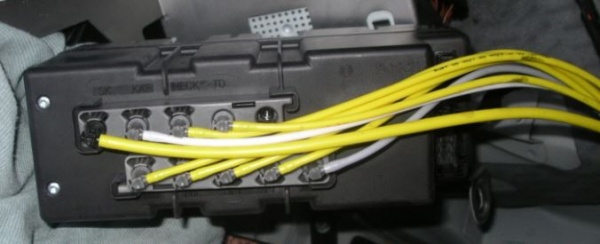
Functions - Pneumatic System Equipment (PSE) Pump
On a M-B W220 2003 Update S500 LWB:
- Locking/Unlocking of Doors,
- Soft/Self Close Function for Doors,
- Inflation of Lumbar Support Bladders,
- Operation of Fuel Filler Flap Lock, (For manual release see WIS 47.00 Fuel Filler Cover)
- Extension and retraction of the Boot/Trunk Handle,
- Releases the Child Safety Lock on Rear Doors in an emergency,
- Operation of the Boot/Trunk Catch for auto opening and closing, and
- Another function (KAF) ?? TBD (possibly a vent for the Pump or a means of providing vacuum to the vacuum reservoir when the car is not running).
Summary of Designations and Functions- Pneumatic System Equipment (PSE) Pump
The W220 S-Class Pneumatic System Equipment (PSE) Pump has each Port designated with Capital Letters:
SK, KAF, HECK, TD, Blank
......FoR, FoL, BFT, FT and MKL.
See next Figure for PSE Pump Air Line Port Designations.
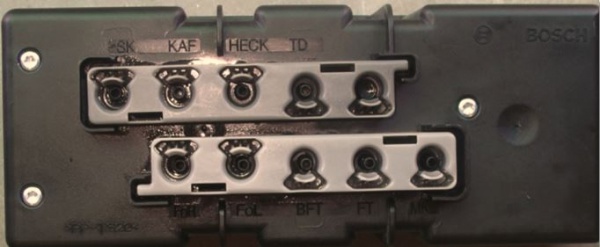
| Pneumatic System Equipment (PSE) Pump Port Connector and Air Line Colour | Designation | Function in W220 2003 Update S500L |
|---|---|---|
| Black connector/large yellow air line | SK | Rear Seat Head Restraints |
| Grey connector /white air line | KAF | Unknown ?? TBD (possibly a vent for the Pump or a means of providing vacuum to the vacuum reservoir when the car is not running). |
| Grey connector /yellow air line | HECK | Boot/Trunk Catch Actuator and Handle Retractor |
| Grey connector /yellow air line | TD | Fuel Filler Flap Lock |
| Not Used | ||
| Grey connector /yellow air line | FoR | Rear Right Door Lock, Child Safety Door Lock Release and Soft/Self Close |
| Grey connector /yellow air line | FoL | Rear Left Door Lock , Child Safety Door Lock Release and Soft/Self Close |
| Grey connector /yellow air line | BFT | Front Left Door Lock and Soft/Self Close |
| Grey connector /yellow air line | FT | Front Right Door Lock and Soft/Self Close |
| Grey connector /grey air line | MKL | Multi Contour Backrest (Lumbar Support Bladder all four seats) |
Location - Pneumatic System Equipment (PSE) Pump
The Pneumatic System Equipment (PSE) Pump is located in the Boot/Trunk in a foam lined compartment in the left rear fender well, above the GPS Navigation Unit and is hidden from view by the Boot/Trunk Liner.
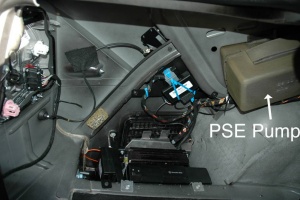
Baseline Pressure Tests - Pneumatic System Equipment (PSE) Pump
In order to establish a base line performance the following pressure tests were conducted and the results recorded as each feature was run through it’s full range of operation.
The pressure readings were obtained with a home made dual gauge set, comprising a Vacuum Gauge and a Pressure Gauge teed together, and then this dual gauge teed into each air line in turn.
The appropriate function was then operated as per normal whilst observing the dual gauges. By necessity each air line had to be disconnected and then reconnected with the tee piece in line for each test. This may have some impact on the results as the Pump is very aware that the line has been disconnected. According to Brett Allison in the reference, the W140 Close Assist Pump will cease to control a particular air line if it detects a fault several times in a row. This condition is corrected by unplugging the large connector on the PSE Pump, waiting a minute or so and reconnecting, which apparently resets the electronics.
| PSE Pump Port Designation | Function in W220 2003 Update S500 LWB | Pressure Tests (Note Non-Existent Soft Close Function on All Doors) |
|---|---|---|
| SK | Rear Seat Head Restraints | Switch Head Restraints up, get -ve pressure (4”Hg vacuum), the head restraints go up, then returns to atmospheric pressure.
Switch Head Restraints down, no change in pressure (atmospheric), Head Restraints go down. |
| KAF | Unknown ?? | Unknown ?? |
| HECK | Boot/Trunk Catch Actuator and Handle Retractor | Close Boot/Trunk with Key Remote, get +ve pressure (110KPa or 16psi), Boot/Trunk Catch Actuator pulls boot closed, then –ve pressure (19”Hg vacuum), which retracts Handle, then returns to atmospheric pressure.
Open Boot/Trunk with Key Remote, get +ve pressure (110KPa or 16psi), which extends Handle, and unlocks Boot/Trunk, releasing lid which fully opens, then returns to atmospheric pressure. |
| TD | Fuel Filler Flap Lock | Lock car using Remote Key, get +ve pressure (28Kpa or 4psi), which moves pin out to lock Fuel Filler Flap, then returns to atmospheric pressure.
Unlock car using Remote Key, get -ve pressure (8”Hg vacuum), which retracts pin to unlock Fuel Filler Flap, then returns to atmospheric pressure. |
| Not Used | ||
| FoR | Rear Right Door | Lock car using Remote Key, get +ve pressure (14Kpa or 2psi), which pulls Rear Right Door Lock Button down, then returns to atmospheric pressure.
Unlock car using Remote Key, get -ve pressure (9”Hg vacuum), which moves Rear Right Door Lock Button up, then returns to atmospheric pressure. Soft Close Feature (Where Fitted TBD) |
| FoL | Rear Left Door | Lock car using Remote Key, get +ve pressure (24Kpa or 3.5psi), which pulls Rear Left Door Lock Button down, then returns to atmospheric pressure.
Unlock car using Remote Key, get -ve pressure (9”Hg vacuum) which moves Rear Left Door Lock Button up, then returns to atmospheric pressure. Soft Close Feature (Where Fitted TBD) |
| BFT | Front Left Door | Lock car using Remote Key, get +ve pressure (24Kpa or 3.5psi), which pulls Front Left Door Lock Button down, then returns to atmospheric pressure.
Unlock car using Remote Key, get -ve pressure (9”Hg vacuum), which moves Front Left Door Lock Button up, then returns to atmospheric pressure. Soft Close Feature (Where Fitted TBD) |
| FT | Front Right Door | Lock car using Remote Key, get +ve pressure (21Kpa or 3psi), which pulls Front Right Door Lock Button down, then returns to atmospheric pressure.
Unlock car using Remote Key, get -ve pressure (9”Hg vacuum), which moves Front Right Door Lock Button up, then returns to atmospheric pressure. Soft Close Feature (Where Fitted TBD) |
| MKL | Multi Contour Backrest (Lumbar Support Bladder all seats) | When the MKL Air Line is connected it always has +ve pressure (55Kpa or 8psi). If the MKL Air Line is disconnected each Lumbar Support Bladder remains inflated until it’s Adjustment Control on the edge of the seat is returned to ‘0’. You can hear the air escaping from the Adjustment Control. |
Issues - Pneumatic System Equipment (PSE) Pump
Pump Fails to Work Due to Pneumatic Leaks
- The PSE pump contains electronics which has memory and will disable some functions if they do not work properly for whatever reason. For example a leak in a line or actuator may cause the pump to run for too long. The electronics may disable the pump in this situation.
- The solution is to reset the pump which should restore functionality, even if temporarily. If the fault persists the pump will most likely be disabled again.
Pump Fails to Work Due to Blocked Pump Ports
- Some functions may not work due to a build up of a fine black powder inside the PSE pump which blocks the relevant port.
- The solution is to dismantle the pump and clean any contamination from the pump head or internal lines. The following contaminated area was provided by BenzWorld poster, GotBenz.
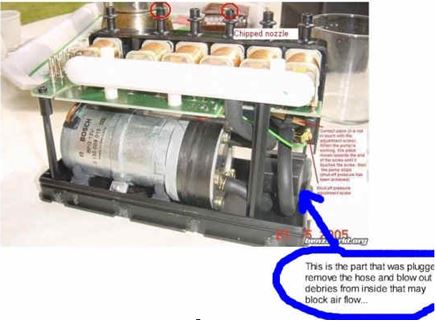
Pump Fails to Work Due to Over Heating
- The Retractable Trunk Grip (RTG) ie the pneumatically controlled hidden chrome handle failed when the car was locked and left parked. Next morning the car wouldn’t unlock because the battery voltage had drained to 6.4V. The PSE pump had been running all night and melted the discharge plastic port on the pump.
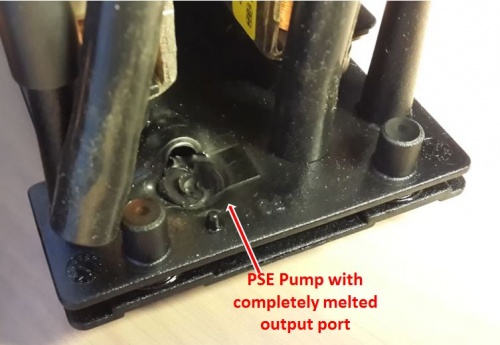
- In this next vehicle the PSE pump output port is still intact but is leaking through a small hole which was created when the heat from the pump softened the plastic. It was only a matter of time before this pump would fail completely.
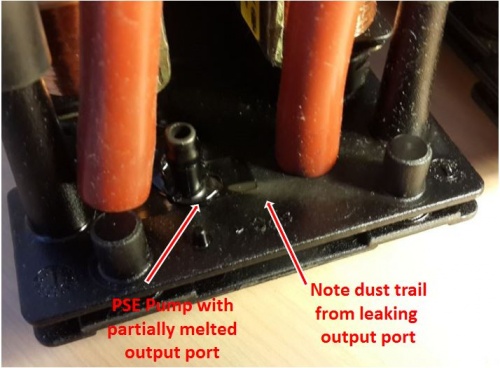
- The solution is to buy a new or second hand pump and after fitting reprogram the pump to the car using STAR.
Resetting - Pneumatic System Equipment (PSE) Pump
Resetting of the PSE pump is accomplished by either pulling the 20 amp fuse under the Rear Right Seat or disconnecting the main connector to the PSE pump for thirty seconds.
Accessing - Pneumatic System Equipment (PSE) Pump
Warning: DO NOT remove any of the Air Lines before ANNOTATING them. The PSE Pump Ports are marked but the Air Lines are not.
- Remove the plastic panel at the rear most edge of the Boot/Trunk opening.
- Remove the left Boot/Trunk liner.
- It is not necessary to touch either the GPS Navigation or the CD Player.
- It helps to remove the Boot/Trunk Lining under the back window after also removing the Battery Cover and the right Boot/Trunk liner but it is not absolutely necessary.
- Note the Air Lines are connected to the pump by snap-on connectors.
Testing and DIY Repairs - Pneumatic System Equipment (PSE) Pump
Test Pneumatic Lines for Leakage
The best method for determining which lines are leaking is to perform leakage tests on each pneumatic line when disconnected from the PSE Pump. Firstly remove the PSE Pump.
Remove PSE Pump
- Remove battery earth connection.
- Remove Trunk/boot left side lining. See WIS 88.50 Trunk/Boot Lid.
- Remove TV Tuner if fitted.
- Remove insulating cover from PSE Pump.
- Withdraw PSE Pump from its insulated box.
- Annotate each line with the designation matching that found on the PSE Pump.
Leakage Testing Pneumatic Lines
- Carefully prise one pneumatic line from the PSE port.
- Connect a MityVac hand operated vacuum pump to the open pneumatic line.
- Apply negative vacuum. (Note some long lines with large actuators will require considerable pumping.
- Observe the result on the MityVac gauge. It should hold a steady vacuum if there are no leaks.
- If leaks are observed you will need to work your way towards the relevant actuator and repeat wherever it is convenient.
- Replace the pneumatic line.
- Repeat the vacuum test on the next pneumatic line.
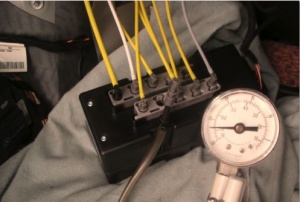
Pressure Test Results - PSE Pump
A vacuum gauge and a pressure gauge were teed together to make a +ve and -ve pressure tester which was then teed into each PSE Pump output port to measure the resulting operational pressures.
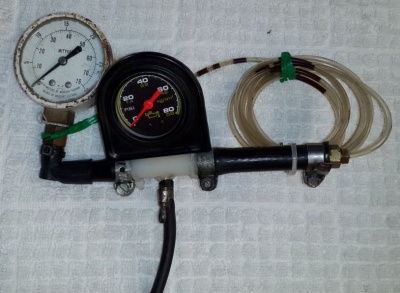
A thorough description and results of pressure tests can be found at BenzWorld Post #15:
http://www.benzworld.org/forums/w220-s-class/1631298-does-my-s500-have-soft-self-2.html
and 2002 S430 Pneumatic System Equipment (PSE) Pump at:
http://www.benzworld.org/forums/w220-s-class/1571979-pse-pump-air-lines.html
Understanding a PSE Pump
An excellent article by Brett Allison titled "Getting to know your Closing Assist Pump: Function, Tips, and Fixes" is at:
http://v12uberalles.com/Closing_Assist_Pump.htm
DIY Repair - PSE Pump
Dismantling - PSE Pump
Once the PSE pump is on the bench it can be dismantled:
- Remove the three Torx screws on the top case.
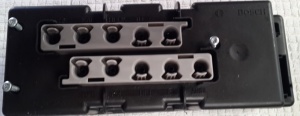
- Prise open the top and bottom covers using the prise points.
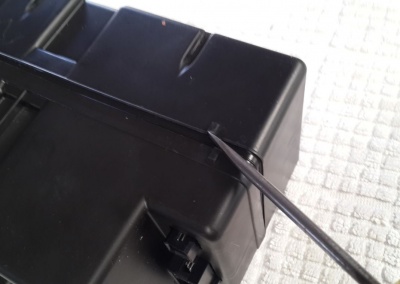
- Remove the white plastic holder at the Suction and Discharge Ports.
- The Port closest to the observer in the next photograph is designated 'X' and is the discharge or +ve pressure port.
- The Port furthest away from the observer in the next photograph is designated 'Y' and is the suction or vacuum or -ve pressure port.
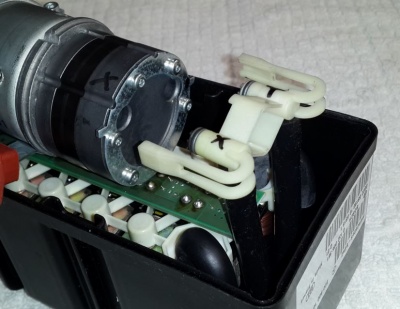
- Carefully note the location and order of the port fittings.
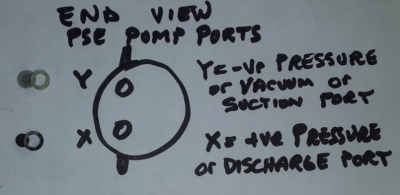
- The discharge or +ve pressure port designated 'X' has a small diameter rubber one way valve and holder fitted into it.
- The suction or vacuum or -ve pressure port designated 'Y' has a small diameter gauze filter and holder fitted into it.
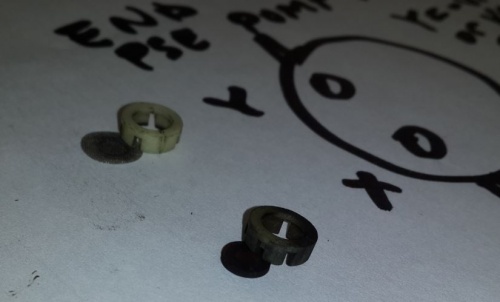
- Unsolder the red and black wires at the pump motor.
- Unclip the grey plastic port surrounds and put to one side. They are identical.

- Withdraw the whole internal assembly.
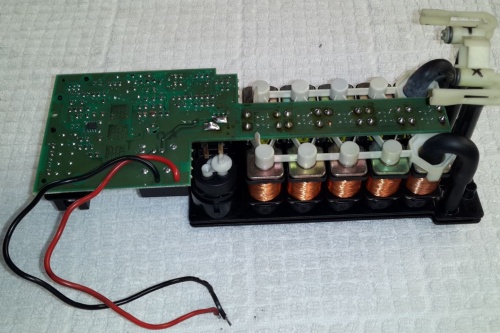
DIY Overhaul - PSE Pump
A thorough description of a PSE Pump Overhaul by BenzWorld Member evolotion is at;
http://www.benzworld.org/forums/w220-s-class/1563160-pse-central-locking-pump-overhall.html
Lessons Learned - Pneumatic System Equipment (PSE) Pump
Need to Annotate the Pneumatic Lines
- DO NOT remove any of the Air Lines before ANNOTATING them. The PSE Pump Ports are marked but the Air Lines are not.
Need to Reprogram a New PSE Pump
- A NEW OR USED REPLACEMENT PSE CONTROL MODULE MUST BE PROGRAMMED TO YOUR CAR. This is very, very, very important. The same PSE pump model is used on multiple Benz body styles, and even on the same body style not every car has all of the same options. If it is not programmed (via STAR) it will cause the pump to run much longer than necessary and will burn out the motor.
http://www.benzworld.org/forums/w220-s-class/1654318-pse-soft-close-assist-lessons-learned.html
Do Not Add Additional Lubrication
- Reference BenzWorld Member 'evolotion': The PSE pump is made of a material which is self lubricating. Hence if you were to introduce a liquid lubricant such as WD40 into the motor or pump, any deposits generated during normal operation would stick to the liquid, and before you know it the liquid becomes a paste, to be more precise, a grinding paste.
Fix a Faulty Pump or Pneumatic Lines Promptly
- A PSE pump and associated pneumatic lines with a fault should be repaired promptly. If the pump runs continuously or excessively for too long it will burn out. Note this also applies to a new pump which has not been properly programmed to the car. If it doesn't match the car's equipment it will burn out through excessive operation.
It Is Unsafe to Drive a Car Without a Working PSE Pump
- In the event of an accident the PSE pump unlocks all doors and releases the Child Safety Lock on Rear Doors.
- A non functioning PSE Pump will possibly prevent or at the worst delay first responders from gaining access to a crashed vehicle in the event of an emergency.
Part Numbers - Pneumatic System Equipment (PSE) Pump
2003 Update W220 S500 OEM PSE Part Number:
- >PP-TS20<
- MB 220 800 10 48 [08]
- BOSCH 0 132 006 381
- (944)
- 0022 03190 10 0315 1 001 Made in France
As usual confusion reigns regarding part numbers.
- One BenzWorld Member called his dealer to verify the part number and apparently all the PSE vacuum pumps are the exact same pump, M-B just kept changing the part number every year,
- 220 800 02 48 is the oldest part number, then keeps going up to
- 220 800 03 48,
- 220 800 05 48,
- 220 800 10 48 etc.
But it’s all the same pump so they will all work.
- Another BenzWorld member says only the newest pump will work for sure. The difference is in the electronics basically. Older pumps for example do not support the remote trunk closure option.
- Another post says, I checked the part numbers on the compatibility, and although 220 800 05 48 is an older version than 220 800 11 48, they are interchangeable.